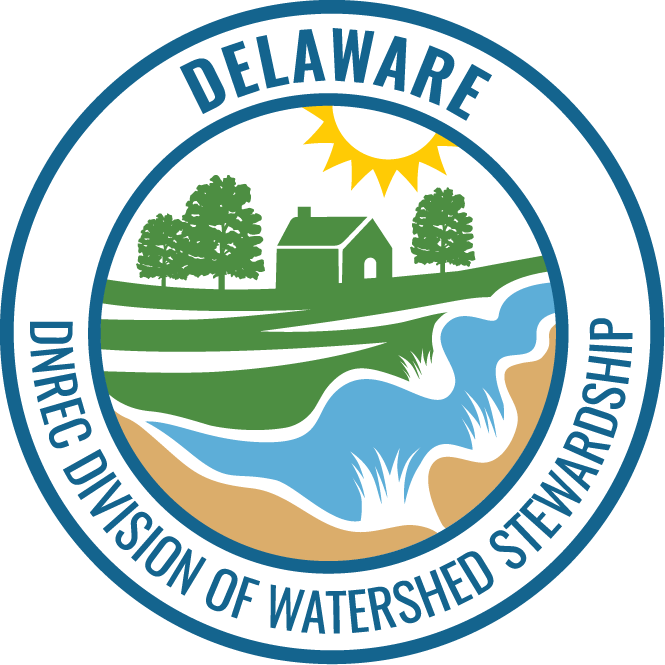
Facebook Twitter Instagram YouTube
Written on: September 19th, 2017 in Wetland Animals
By Brittany Haywood, DNREC’s Wetland Monitoring and Assessment Program
Did you know that Delaware has multiple species of crayfish? While crayfish may look like small lobsters, they are actually distant cousins. The most differentiating feature is that lobsters live in saltwater, and crayfish, crawfish, crawdads, or whatever you would like to call them, live in fresh to brackish waters.
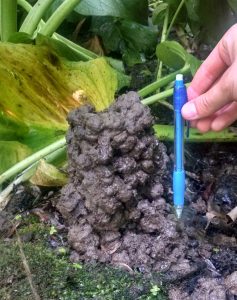
Some crayfish species living in Delaware are naturally occurring here (native), while some come from other parts of the country (invasive), and they all come in various colors and sizes. You are likely to find these crustaceans in flowing streams, lakes, swamps, ponds, and seasonally wet wetland habitats. They live their lives safely burrowed in underground tunnels or hiding out in open water, or some combination of the two. Fun fact, as long as the crayfish’s gills stay moist, it can breathe on land or in the water.
Crayfish are opportunistic feeders using the two antenna on the top of their head to seek out the chemicals that “smell” most tasty to them. They will chow down on decomposing plant or animal parts, slow moving macroinvertebrates such as snails, underwater grasses, amphibians, and fish eggs. Interestingly enough though, juvenile crayfish seem to prefer a diet consisting of mostly meat, while adult crayfish seem content munching away on plant materials.
On the other hand, crayfish also serve as a tasty treat to bass, snapping turtles, raccoons, and herons, and are used as bait by fisherman to catch fish.
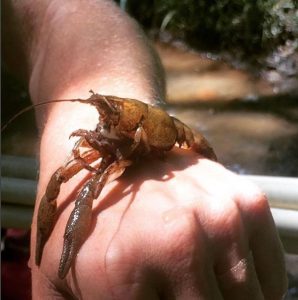
These hard-shelled critters also have interesting behaviors. To escape a predator, they will try to tail flip themselves away. Don’t think they are wimps though, because they aren’t afraid to get down and dirty. Fighting is commonplace among crayfish, whether it be over food, shelter, or selecting the perfect mate. They box, push, grasp, and grab at their opponent until one submits or loses a limb.
But, how does one crayfish know when the other has submitted? Crayfish have developed body language and chemical signals that let their opponent know when they’ve given up. If a crayfish lays its body flat against the ground with its claws forward, or if it does a tail flip and propels itself backwards, it has submitted and the battle is over.
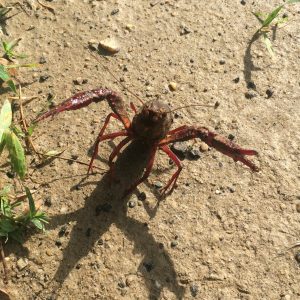
Crayfish behaviors can vary by species, especially when it comes down to aggression. For example, the red swamp crayfish (Procambarus clarkii) is known for its very aggressive behavior and delicious taste, and it just so happens to be an invasive species right here in Delaware. It uses its aggressive behavior to out-compete native species of crayfish and amphibians for shelter and food.
Native to the U.S.’s Gulf Coast, the red swamp crayfish made its way to Delaware through people releasing or disposing them as unwanted food, pets, or bait. One paper from Indiana hypothesized that flushing crayfish down the toilet was an inappropriate way to dispose of them because they were being found around waste water treatment facilities, “having apparently survived treatment.”
Long story short, crayfish are cool, but the invasive species are bad, and never flush unwanted animals—including crayfish– down the toilet because you never know where they might end up (or what they might turn into).
Red Swamp Crayfish Identification:
• Tolerates a range of salinities and pollution
• Can grow up to 5 inches long
• Dark red in color
• Raised bright red spots on claws and body
• Juveniles are not red and can be difficult to identify
• Have an approximate two year life span in the wild
• If you see one, please report it to the Delaware Division of Fish and Wildlife at 302-735-8655
Written on: September 19th, 2017 in Wetland Assessments
By Kari St.Laurent, DNREC’s Delaware National Estuarine Research Reserve
Wetlands are more than just a beautiful photo opportunity. If you are a reader of this blog, you are probably aware that tidal wetlands can protect shorelines from storm surge, reduce nutrients, and provide habitat for critters like shellfish, crabs, and fish. These benefits are collectively known as ecosystem services. Recently, there is another ecosystem service that has been gaining interest from wetland scientists, coastal resources managers, and policy-makers alike – the ability for tidal wetlands to trap and store carbon!
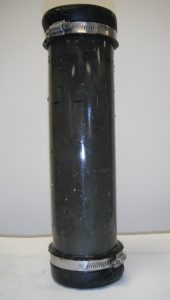
Tidal wetlands can store mass amounts of carbon within its thick layers of sediment. Plants, including Spartina alterinflora, take in atmospheric carbon dioxide during photosynthesis and turn it into part of their cellular structure. When these marsh plants die, that carbon can be buried into the marsh sediment where it can stay trapped as organic matter for millennia. Organic matter can also be deposited onto a marsh by tides and water coming off from land. This process of carbon going from the atmosphere into marsh plants and sediments is called carbon sequestration.
One key feature of a tidal marsh is its ability to accrete, or be able to vertically build-up sediment to keep pace with local sea level changes. As this layer of marsh sediment gets deeper and deeper, it becomes harder for this trapped carbon to get released back into the atmosphere. Thus, marshes can be a sink for carbon dioxide!
This storage of carbon within tidal wetland ecosystems has earned the name blue carbon. Impressively, tidal wetlands can store more carbon per area than a forest because of its deep layers of mud – measured as deep as 32 feet in Belize. And that carbon in a tidal wetland can be stored for 1000’s of years while systems like a rainforest store carbon for shorter periods, such as decades to centuries. This makes blue carbon an important component of the global carbon cycle.
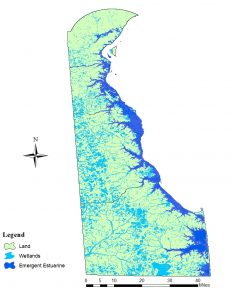
Healthy marshes will continue to trap and store carbon, in addition to providing valuable habitat, protection from storms, and natural filtration of nutrients. However, when marshes are lost or degraded, that carbon storage benefit is lost – and even more, that previously stored carbon can be released back into the environment. The protection and restoration of wetlands is a great way to help continue carbon sequestration and storage within tidal wetlands.
So just how much carbon is sequestered each year within Delaware’s approximately 73,000 acres of tidal wetlands? This past summer, DNREC-Delaware Coastal Programs hosted Bryce Stevenosky, a DENIN intern from the University of Delaware, to help us understand this question using published scientific literature. While this is just a back-of-the-envelope type of estimate, it starts to put the amount of blue carbon into perspective for Delaware’s wetland scientists.
Bryce estimated the amount of carbon sequestered each year into Delaware’s marsh sediments is 57,000 metric tons of carbon dioxide. To put this into perspective, the average car emits 4.7 metric tons of carbon each year. This means that Delaware’s wetlands sequester the emissions of over 12,000 cars each year. That’s greater than the population of Smyrna!
This estimate is just the beginning for Delaware’s coastal resources managers and scientists to understand the role wetlands play in storing carbon dioxide, and what we could stand to lose if wetlands are lost. More work needs to be done in Delaware to understand these complex processes and put a site-by-site specific value on just how much carbon Delaware’s tidal wetlands are trapping for us.
Written on: September 13th, 2017 in Wetland Restoration
By John G. Cargill, IV, DNREC Division of Watershed Stewardship/Division of Waste and Hazardous Substances
The National Vulcanized Fiber (NVF) plant located in Yorklyn, Delaware has a rich history with humble beginnings in grist, snuff, lumber, and cotton. By the mid 1800s, production in the valley shifted to paper, and by the early 1900s shifted again to vulcanized fibre. Due to the early success of fibre production, the local Marshall Brothers Company expanded into the National Fibre and Insulation Company and later into the NVF Company. Operations at NVF between 1960 and 2003 were busy. The main mills and the Marshall Brothers Mill were operated 24 hours a day, 7 days a week, moving approximately 40-41 million pounds of material annually. Eventually demand and production slowed, and by 2008 the staffing and traffic of the mills had reduced to about ¼ of the totals from the height of the company. By 2009, the NVF Company had declared bankruptcy and shut down the facility for good.
At the same time that NVF operations were winding down, the Department of Natural Resources and Environmental Control’s (DNREC) Division of Parks and Recreation (Parks) was acquiring land in and around the valley. By the end of 2008, Parks was managing 192 acres of valuable conservation and cultural resource lands known as Auburn Heights Preserve (which also includes the original Marshall family mansion and its steam car museum) and another 121 acres known as the Oversee Farm. Between the two areas of conservation land, and adjacent to the Red Clay Creek, was the former NVF Company plant. Here’s where things get interesting…
Concerns and interest in the NVF properties were far reaching. DNREC’s Division of Waste & Hazardous substances was concerned about hazardous materials and unknown environmental issues; DNREC’s Division of Water Resources was concerned about known impacts to aquatic life in the Red Clay Creek from plant operations; DNREC’s Division of Soil and Water Conservation was focused on historic flooding problems and the hazards posed by an abandoned facility in the flood plain; DNREC’s Division of Parks and Recreation saw an opportunity to connect its other properties in the valley; private investors were interested in the redevelopment potential of creek-side property; and the surrounding community was concerned about all of it. So now what ?
Working as a unit, DNREC put together a multi-divisional working group that began to secure the site and gather information about environmental conditions at the site. DNREC Parks worked with a private investment group to acquire the 119 acres of NVF Company land from the Bankruptcy Trustee, and soon after negotiated rights to various parcels for future Park related development and connection of existing Park amenities. Through this unique partnership, DNREC assumed responsibility for the assessment and environmental cleanup of the former plant properties, while the private developer took responsibility for all asbestos abatement and demolition of existing unwanted structures.
Fast forward to August 2017. All of the structures that will not be redeveloped have been demolished. The feasibility study conducted to determine the best cleanup options for contaminated portions of the property has been, more or less, implemented and completed. Aside from the continuously operating groundwater remediation system that keeps dissolved zinc in groundwater from entering the Red Clay Creek, the most aggressive and costly portion of site remediation entailed zinc source removal (from soil) and creation of a 2-acre wetland to serve as flood water storage capacity.
During the excavation project, over 170 tons (340,000 pounds) of zinc was removed from the soil beneath the former manufacturing facility. In addition, between 500 and 700 pounds of zinc are recovered monthly from the groundwater through the operation of the treatment system.
The majority of non-permeable surfaces have been removed from the site to foster better drainage, and more wetland projects are planned on DNREC owned properties in the valley for additional flood water storage capacity. Finally, pervious paving materials will be used in all roads and parking lots associated with future site redevelopment.
Hazardous Substance Cleanup Act (HSCA) funds have supported approximately $4.5M of the assessment and cleanup efforts, with another $3M on loan from the Clean Water Loan Fund for the zinc source removal/floor mitigation wetland project. Additional State funding is provided to DNREC Parks for ongoing development of trails and other area amenities. At this point in time, the former plant site is ready for additional development, both commercial and/or residential.
Moving forward, the Wilmington and Western Railroad steam train will continue to run through the valley as it always has, but a new turntable and a train station will be added to the former NVF Company property to improve public access to services and amenities. Miles of hiking trail will be accessible from this centralized location, including three historic bridges that will cross the Red Clay Creek within the valley.
An outdoor amphitheater is planned to serve the Delaware Symphony Orchestra as their summer concert home, and residential redevelopment is being planned for one of the former mill building sites (including a stream restoration project along Yorklyn Road).
Public water and sewer are currently being extended to the site to support these and other amenities, including restaurants and shops, that will inevitably follow as the realization of this unprecedented partnership between public and private entities for renewal and revitalization of the Auburn Heights/Yorklyn Valley area are realized.